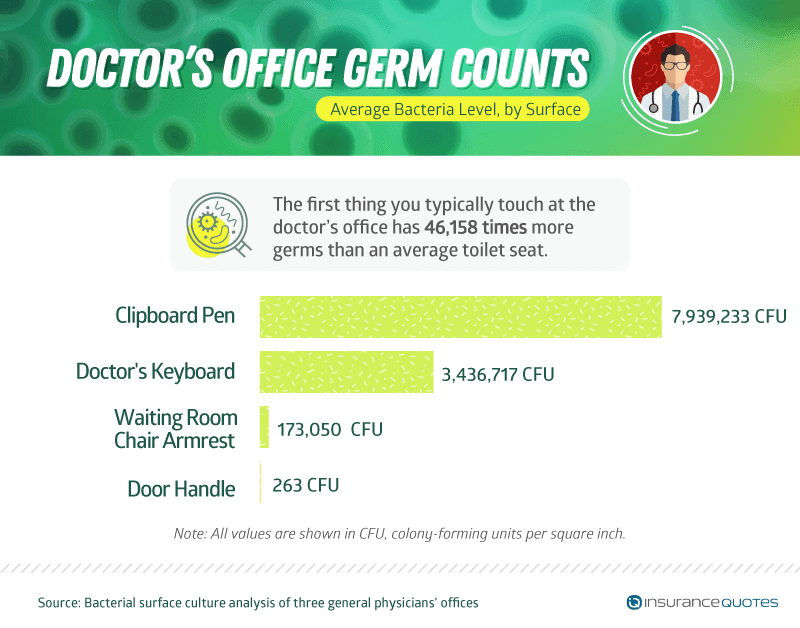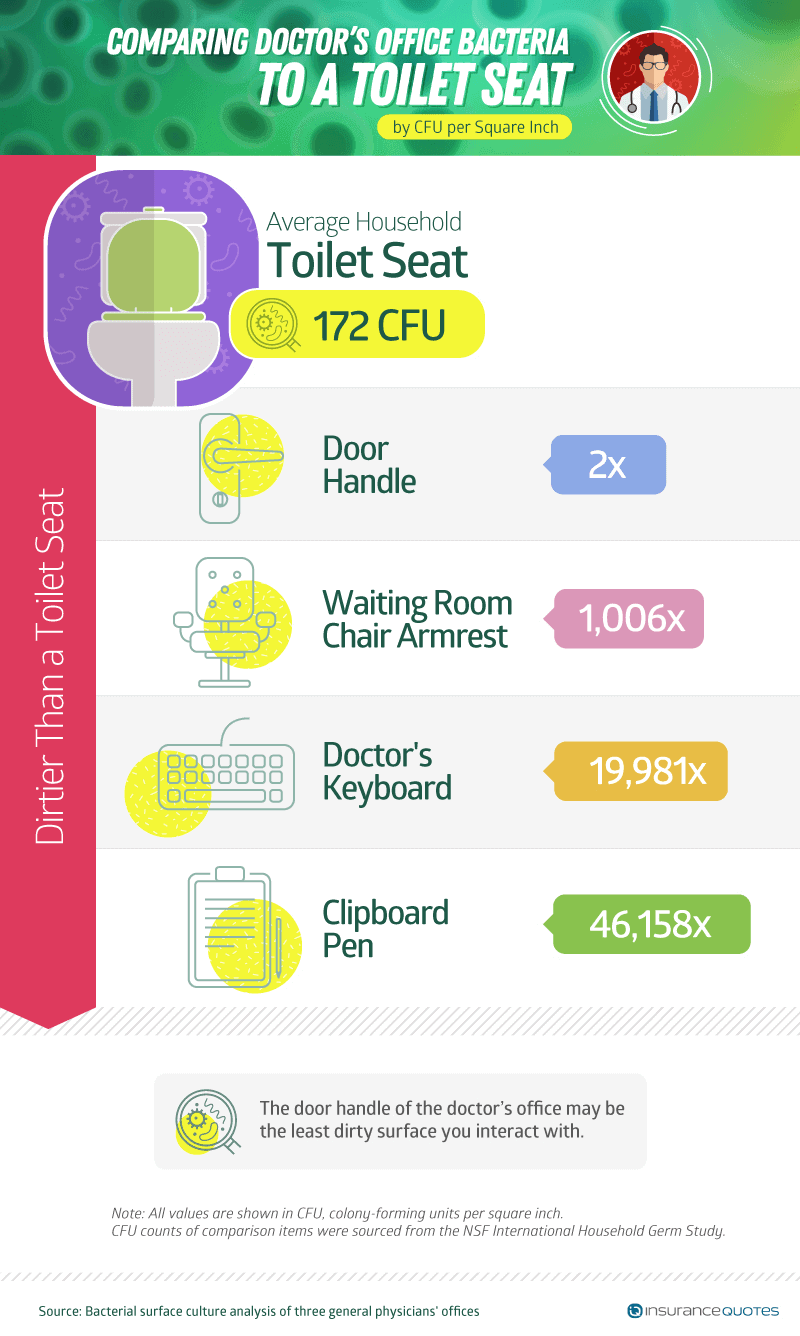Germs at the Doctor’s Office

Going to the doctor is certainly not ranked among Americans’ favorite pastimes – although the process can be a little more pleasant if you’ve found the right primary care specialist for you. One of the less palatable parts of heading to your annual checkup is the symphony of coughing and sneezing that surrounds you once you arrive, threatening your health at seemingly every turn.
We wanted to put the higher-than-average concentration of germs flying around any given doctor’s office under the microscope – literally. There are more than 200 strains of the common cold, so we set our sights on finding out exactly what bacteria may be lurking around and where.
Armed with a swab and some hand sanitizer, we tested a few commonly used items around three general physicians’ offices to see which one should be crowned the germiest.
How Germy Is the Doctor’s Office?

Before signing in at the reception, you might want to put on a hazmat suit.
Our bacterial surface culture analysis of a few general doctors’ office items revealed the clipboard pen was alive with germs to the tune of almost 8 million colony-forming units (CFU) per square inch. If that term has you scratching your head, it simply refers to the bacteria’s capability to live and reproduce to form other bacteria of the same kind.
While 8 million CFU is nothing to shake a stick at, don’t forget we’re dealing with microscopic organisms – they tend to gather en masse. For example, when it comes to the healthy bacteria in probiotic capsules, you should expect to consume at least 1 billion CFU to do the trick.
The doctor’s keyboard was the second most germ-covered surface, at just under 3.5 million CFU, or less than half of what was found on the pen. Surprisingly, given how many hands make contact with the doctor’s office door handle each day, it came up with a negligible amount of bacteria: just 263 CFU. It looks like these locations are doing much better than one particular Starbucks in NYC, which boasted door handles that were found to be dirtier than the poles in subway trains!
Germs in Context
 Toilet seats are the first things people turn to when it’s time to compare germy surfaces. However, the humble toilet seat seems to be treated too harshly most of the time and can be eclipsed in its contamination by commonly used items such as cellphones and, according to our study, the dreaded clipboard pen.
Toilet seats are the first things people turn to when it’s time to compare germy surfaces. However, the humble toilet seat seems to be treated too harshly most of the time and can be eclipsed in its contamination by commonly used items such as cellphones and, according to our study, the dreaded clipboard pen.
Given the keyboard is typically in contact with the doctor’s hands most frequently, it’s no wonder it was so alive with germs after encountering sick patients all day. However, the worst offender remained the clipboard pen: Before coming into contact with the doctor, people transferred their rainbow of bacteria to this site upon signing in.
This ubiquitous writing utensil was a staggering 46,158 times dirtier than the average toilet seat. The keyboard was less than half as bacteria-laden and 19,981 times germier than a toilet seat.
Surprisingly, the average door handle at the doctor’s office may be the least germy surface you interact with, being only twice as germy as a typical toilet seat.
Beyond Surface Germs

There was an explosive instance of gram-negative rods inside our chosen doctors’ offices, with nearly 5 million CFU per square inch. You may know of these microscopic critters from illnesses such as pneumonia, blood infections, and surgical site infections. While these type of bacteria were far and away the most prolific, they were only the second most common of all samples taken, with 33 percent of them showing signs of gram-negative rods. We may start to see even more of them lurking around our pens and door knobs as time goes on: These resilient bacteria are crafty and known to have developed resistance to most commonly used antibiotic medications. Yet another reason to wash your hands, folks.
Gram-positive cocci took a distant second, with more than 1.3 million CFU per square inch. However, they were the most common of all, with a presence in 58 percent of samples. Three of the most commonly known strains of these bacteria are Streptococcus (strep throat and impetigo), Staphylococcus aureus (skin infections such as boils), and hemolytic E. coli.
The third most prevalent bacteria type were gram-positive rods, at just over 238,000 CFU per square inch, which was present in 33 percent of samples. These tiny crawlers are usually harmless to humans and not known to cause illnesses other than in very rare cases.
Both bacillus (which can sometimes be at the root of foodborne illness) and actinomycetes (select strains can cause sickness in humans) presented in relatively negligible numbers.
Bring Your Own Pen!
If one thing is certain, people are getting their most concentrated exposure to bacteria within the first few minutes of walking into the doctor’s office thanks to the clipboard pen. It could be a good idea to carry around a personal hand sanitizer to neutralize these microscopic threats on the go in case reception doesn’t have a bottle handy.
Once they returned the clipboard pen, visitors should be safe from relatively high levels of bacterial exposure: The doctor’s keyboard – something patients aren’t even allowed to touch in the first place – was found to be the second germiest fixture in the office.
That being said, our swabs did find the majority of germs in the office were the types to make people sick. Gram-negative rods get an honorable mention for being the most prolific germ, found predominantly on the clipboard pen. Again, this type of bacteria is resistant to antibiotics, so proceed with caution.
The doctor’s office is simply a microcosm of our big, beautiful, bacteria-filled world. Compared to our swab project at the airport, a visit to the doctor could be one of the more germy experiences you’ll have in life. If you’re looking to preserve your health wherever you go and want to be in good hands when you need the proper care, step one is the right health insurance plan. For a comprehensive listing of plans, including coverage for small businesses and those who don’t have insurance through their employer, visit insuranceQuotes.com to get started.
Methodology
We conducted 12 total gram and stain culture swab tests across four items or surfaces at the doctor’s office. Each surface was swabbed three times at three general physicians’ offices. Colony-forming units per swab were averaged for each surface type. Surfaces were chosen based on items we determined were most touched by patients and doctors.
It is possible that with a larger sample size of surfaces, we could have gained more insight into CFU levels. No statistical testing was performed, and claims listed above are based on means alone. As such, this content is exploratory.
Fair Use Statement
Want to share our germy study with like-minded germaphobes? Feel free to link to our work for noncommercial purposes, and give us credit for our swab project!
